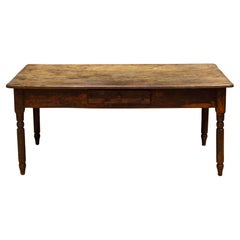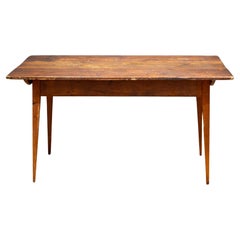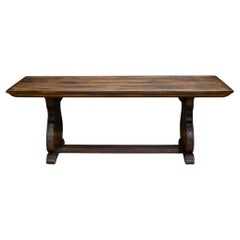Want more images or videos?
Request additional images or videos from the seller
1 of 9
19th C, Rustic Farmhouse Dining Table, c.1880-1890
$2,950List Price
About the Item
- Dimensions:Height: 31.25 in (79.38 cm)Width: 59.5 in (151.13 cm)Depth: 36 in (91.44 cm)
- Style:Rustic (Of the Period)
- Materials and Techniques:
- Period:
- Date of Manufacture:1880-1890
- Condition:Wear consistent with age and use.
- Seller Location:San Francisco, CA
- Reference Number:1stDibs: LU1280227825162
About the Seller
5.0
Platinum Seller
Premium sellers with a 4.7+ rating and 24-hour response times
Established in 2014
1stDibs seller since 2015
1,355 sales on 1stDibs
Authenticity Guarantee
In the unlikely event there’s an issue with an item’s authenticity, contact us within 1 year for a full refund. DetailsMoney-Back Guarantee
If your item is not as described, is damaged in transit, or does not arrive, contact us within 7 days for a full refund. Details24-Hour Cancellation
You have a 24-hour grace period in which to reconsider your purchase, with no questions asked.Vetted Professional Sellers
Our world-class sellers must adhere to strict standards for service and quality, maintaining the integrity of our listings.Price-Match Guarantee
If you find that a seller listed the same item for a lower price elsewhere, we’ll match it.Trusted Global Delivery
Our best-in-class carrier network provides specialized shipping options worldwide, including custom delivery.You May Also Like
Rustic Farmhouse Dining Table, France, 19th Century
Located in Antwerp, BE
19th-century French farmhouse dining table with a naturally aged patina, embodying the timeless beauty of the French countryside. The table’s surface, adorned with colourful paint sp...
Category
Antique 19th Century French Rustic Dining Room Tables
Materials
Wood
Antique Greyed Oak 19th Century French Rustic Farmhouse Dining Table
Located in Nijmegen, NL
This elegant table was made in france in the 19th century. The table was made in solid oak with beautiful grain patterns. It has a very warm color and the table shows marks of use, o...
Category
Antique 19th Century French Rustic Dining Room Tables
Materials
Oak
$2,823
H 30.52 in W 71.66 in D 32.68 in
Antique 19th Century French Rustic Farmhouse Dining Table Fruitwood
Located in Nijmegen, NL
This elegant table was made in France in the 19th century. The table was made in fruitwood with beautiful grain patterns. It has a very warm light color and the table shows many mark...
Category
Antique 19th Century French Country Dining Room Tables
Materials
Fruitwood
$2,371
H 30.71 in W 74.81 in D 31.5 in
Antique Elm 19th Century French Rustic Farmhouse Dining Table
Located in Nijmegen, NL
This elegant table was made in France in the 19th century. It has a tabletop from elm with beautiful grain patterns. It has a very warm color and the table shows many marks of use, o...
Category
Antique 19th Century French Dining Room Tables
Materials
Elm
19th Century Rustic Italian Dining Table
Located in Dallas, TX
19th Century Rustic Italian Dining Table was lovingly hand-crafted from dense, old-growth oak to last for centuries! The top is solid, thick planks of wood dovetailed to join the tw...
Category
Antique Mid-19th Century Italian Rustic Dining Room Tables
Materials
Wrought Iron
Antique Light Elm 19th Century French Rustic Farmhouse Dining Table
Located in Nijmegen, NL
This elegant table was made in France in the early 20th century. The table was made from elm and oak with beautiful grain patterns. It has a very warm but light color and the table s...
Category
Vintage 1910s Dining Room Tables
Materials
Elm
$2,672
H 31.5 in W 78.35 in D 27.96 in
Rustic Farmhouse Dining Table, France, 1950s
Located in Antwerp, BE
This large French farmhouse table from circa 1950 is crafted in solid wood, showcasing the timeless charm of rustic French design. Its generous proportions comfortably seat 8 to 10 p...
Category
Vintage 1950s French Rustic Dining Room Tables
Materials
Wood
Rustic Black Forest ‘19th Century’ Dining Table
Located in Queens, NY
Rustic black forest (19th century) walnut oval dining table with carved faux wood design base and etched floral design top with carved rope edge.
Category
Antique 19th Century German Rustic Dining Room Tables
Materials
Walnut
Rustic Rural Dining Table, France, 19th Century
Located in Antwerp, BE
Farmhouse rustic table from 19th-century France exuding authentic rural charm with its beautifully aged patina. Featuring a single drawer, this table is ideal for use as both a work ...
Category
Antique 19th Century French Rustic Dining Room Tables
Materials
Wood
Rustic Naive Dining Table, France, 19th Century
Located in Antwerp, BE
Rustic dining table in solid wood, a captivating piece from 19th-century Auvergne, France. The artisanal construction of the table legs ensures both durability and stability, promisi...
Category
Antique 19th Century French Rustic Dining Room Tables
Materials
Wood
More From This Seller
View All19th c. Rustic French Farmhouse Table c.1820-1880
Located in San Francisco, CA
ABOUT
A rustic rustic farmhouse table. Two large front drawers with ample storage. Pegged construction visible on the top and on all four tapered legs. The top consists of two wide ...
Category
Antique 19th Century American Rustic Dining Room Tables
Materials
Wood
$2,895 Sale Price
20% Off
19th c. Rustic Farmhouse Table with Large Drawer c.1820-1880
Located in San Francisco, CA
ABOUT
A rustic farmhouse table with turned legs and distressed, painted base. One large, deep front drawer with ample storage. The top consists of three wide planks of wood. Large p...
Category
Antique 19th Century American Rustic Dining Room Tables
Materials
Wood
$2,896 Sale Price
20% Off
Rustic Farmhouse Dining Table
Located in San Francisco, CA
ABOUT
A rustic farmhouse dining table table with an antique wood top. The top consists of three nicely distressed, wide planks of wood. Large ...
Category
Antique Early 19th Century American Rustic Dining Room Tables
Materials
Wood
$1,196 Sale Price / item
20% Off
19th c. Tresle Dining Table c.1880-1900
Located in San Francisco, CA
ABOUT
An original 19th c. tresle dining table table with filigree wood carvings on the base.
CREATOR Unknown.
DATE OF MANUFACTURE c.1880-1890.
MATERIALS AND TECHNIQUES...
Category
Antique 19th Century American Victorian Dining Room Tables
Materials
Wood, Oak
$4,556 Sale Price
20% Off
Large Reclaimed Australian Hardwood Dining Table
Located in San Francisco, CA
ABOUT
This large custom reclaimed hardwood dining table from Melbourne, Australia is perfect for hosting large gatherings. The classic rustic design is made from a reclaimed cricket...
Category
21st Century and Contemporary Australian Rustic Dining Room Tables
Materials
Hardwood
$3,895 Sale Price
24% Off
Midcentury Expandable Danish Teak Dining Table c.1960
Located in San Francisco, CA
ABOUT
An original Danish Teak dining table with expandable draw leaves. Seats six when closed and up to ten when expanded. Original stamp underneath.
CREATOR Attributed to Ansa...
Category
Mid-20th Century Danish Mid-Century Modern Dining Room Tables
Materials
Teak



